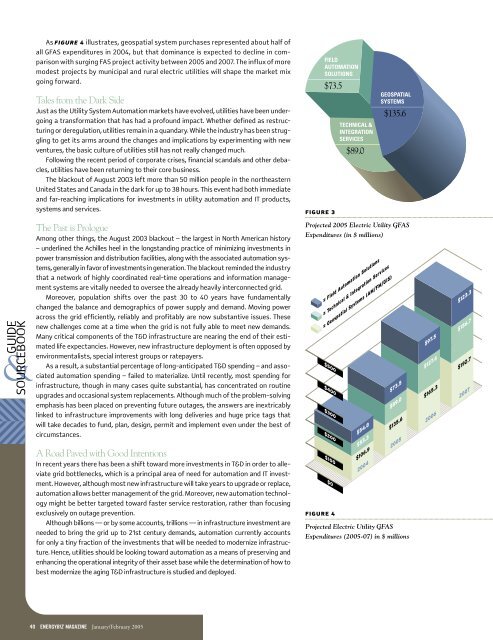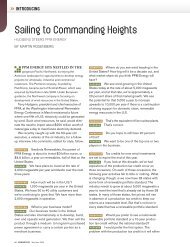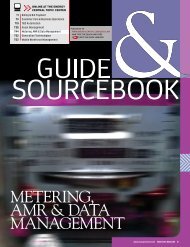utility systems automation - Description
utility systems automation - Description
utility systems automation - Description
You also want an ePaper? Increase the reach of your titles
YUMPU automatically turns print PDFs into web optimized ePapers that Google loves.
As FIGURE 4 illustrates, geospatial system purchases represented about half of<br />
all GFAS expenditures in 2004, but that dominance is expected to decline in comparison<br />
with surging FAS project activity between 2005 and 2007. The influx of more<br />
modest projects by municipal and rural electric utilities will shape the market mix<br />
going forward.<br />
Tales from the Dark Side<br />
Just as the Utility System Automation markets have evolved, utilities have been undergoing<br />
a transformation that has had a profound impact. Whether defined as restructuring<br />
or deregulation, utilities remain in a quandary. While the industry has been struggling<br />
to get its arms around the changes and implications by experimenting with new<br />
ventures, the basic culture of utilities still has not really changed much.<br />
Following the recent period of corporate crises, financial scandals and other debacles,<br />
utilities have been returning to their core business.<br />
The blackout of August 2003 left more than 50 million people in the northeastern<br />
United States and Canada in the dark for up to 38 hours. This event had both immediate<br />
and far-reaching implications for investments in <strong>utility</strong> <strong>automation</strong> and IT products,<br />
<strong>systems</strong> and services.<br />
The Past is Prologue<br />
Among other things, the August 2003 blackout – the largest in North American history<br />
– underlined the Achilles heel in the longstanding practice of minimizing investments in<br />
power transmission and distribution facilities, along with the associated <strong>automation</strong> <strong>systems</strong>,<br />
generally in favor of investments in generation. The blackout reminded the industry<br />
that a network of highly coordinated real-time operations and information management<br />
<strong>systems</strong> are vitally needed to oversee the already heavily interconnected grid.<br />
Moreover, population shifts over the past 30 to 40 years have fundamentally<br />
changed the balance and demographics of power supply and demand. Moving power<br />
across the grid efficiently, reliably and profitably are now substantive issues. These<br />
new challenges come at a time when the grid is not fully able to meet new demands.<br />
Many critical components of the T&D infrastructure are nearing the end of their estimated<br />
life expectancies. However, new infrastructure deployment is often opposed by<br />
environmentalists, special interest groups or ratepayers.<br />
As a result, a substantial percentage of long-anticipated T&D spending – and associated<br />
<strong>automation</strong> spending – failed to materialize. Until recently, most spending for<br />
infrastructure, though in many cases quite substantial, has concentrated on routine<br />
upgrades and occasional system replacements. Although much of the problem-solving<br />
emphasis has been placed on preventing future outages, the answers are inextricably<br />
linked to infrastructure improvements with long deliveries and huge price tags that<br />
will take decades to fund, plan, design, permit and implement even under the best of<br />
circumstances.<br />
A Road Paved with Good Intentions<br />
In recent years there has been a shift toward more investments in T&D in order to alleviate<br />
grid bottlenecks, which is a principal area of need for <strong>automation</strong> and IT investment.<br />
However, although most new infrastructure will take years to upgrade or replace,<br />
<strong>automation</strong> allows better management of the grid. Moreover, new <strong>automation</strong> technology<br />
might be better targeted toward faster service restoration, rather than focusing<br />
exclusively on outage prevention.<br />
Although billions — or by some accounts, trillions — in infrastructure investment are<br />
needed to bring the grid up to 21st century demands, <strong>automation</strong> currently accounts<br />
for only a tiny fraction of the investments that will be needed to modernize infrastructure.<br />
Hence, utilities should be looking toward <strong>automation</strong> as a means of preserving and<br />
enhancing the operational integrity of their asset base while the determination of how to<br />
best modernize the aging T&D infrastructure is studied and deployed.<br />
40 ENERGYBIZ MAGAZINE January/February 2005<br />
FI GURE 3<br />
Projected 2005 Electric Utility GFAS<br />
Expenditures (in $ millions)<br />
FI GURE 4<br />
Projected Electric Utility GFAS<br />
Expenditures (2005-07) in $ millions
















![View From the Trenches [PDF]](https://img.yumpu.com/18854438/1/190x252/view-from-the-trenches-pdf.jpg?quality=85)